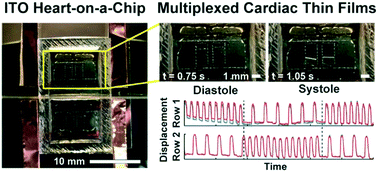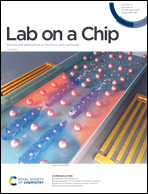Contact photolithography-free integration of patterned and semi-transparent indium tin oxide stimulation electrodes into polydimethylsiloxane-based heart-on-a-chip devices for streamlining physiological recordings†
Abstract
Controlled electrical stimulation is essential for evaluating the physiology of cardiac tissues engineered in heart-on-a-chip devices. However, existing stimulation techniques, such as external platinum electrodes or opaque microelectrode arrays patterned on glass substrates, have limited throughput, reproducibility, or compatibility with other desirable features of heart-on-a-chip systems, such as the use of tunable culture substrates, imaging accessibility, or enclosure in a microfluidic device. In this study, indium tin oxide (ITO), a conductive, semi-transparent, and biocompatible material, was deposited onto glass and polydimethylsiloxane (PDMS)-coated coverslips as parallel or point stimulation electrodes using laser-cut tape masks. ITO caused substrate discoloration but did not prevent brightfield imaging. ITO-patterned substrates were microcontact printed with arrayed lines of fibronectin and seeded with neonatal rat ventricular myocytes, which assembled into aligned cardiac tissues. ITO deposited as parallel or point electrodes was connected to an external stimulator and used to successfully stimulate micropatterned cardiac tissues to generate calcium transients or propagating calcium waves, respectively. ITO electrodes were also integrated into the cantilever-based muscular thin film (MTF) assay to stimulate and quantify the contraction of micropatterned cardiac tissues. To demonstrate the potential for multiple ITO electrodes to be integrated into larger, multiplexed systems, two sets of ITO electrodes were deposited onto a single substrate and used to stimulate the contraction of distinct micropatterned cardiac tissues independently. Collectively, these approaches for integrating ITO electrodes into heart-on-a-chip devices are relatively facile, modular, and scalable and could have diverse applications in microphysiological systems of excitable tissues.



 Please wait while we load your content...
Please wait while we load your content...